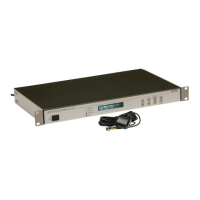148 Options List
C.14.10 Changing Hardware Settings via Internal Jumpers
It is necessary to set a jumper in order to assign the output signal to a specific I/O connector. The
following paragraphs describe the procedure for setting these jumpers.
Cover Removal
To change the I/O configuration of the rear-panel connectors, the top cover of the instrument must
be removed. Turn off the instrument, and disconnect the power cord. Using a T-25 driver, remove
the four screws holding the cover (and rack mount ears, if used) in place, and lift the cover off.
WARNING: DO NOT REMOVE top cover while power is applied. Hazardous voltages are
present while the power cord is connected. Always disconnect the unit from the input power source
before removal of the top cover.
The Option 23 COMTRADE Board is illustrated in Figure C.16, which shows the location of all
the jumpers along with a brief description.
Output Function Selection
Jumpers JMP1, JMP2, JMP3, and JMP4 determine the output signals which can be made available
at I/O connectors J2, J3, J4, and J5, respectively. Figure C.16 illustrates the relationship between
these jumpers and the I/O connectors. The first step in setting an I/O channel for a specific
output signal is to move the associated jumper to the location corresponding to the desired signal.
Table C.8 lists the jumper settings required for various signals.
Output Mode Selection
The next step in configuring the I/O connectors is to determine whether the assigned signal is an
analog output or a digital output. This selection is accomplished by setting jumpers JMP5, JMP6,
JMP7, and JMP8 to the appropriate positions. These jumpers correspond to connectors J2, J3,
J4, and J5, respectively (see Figure C.16). If the I/O channel is to be used as a digital output, the
corresponding jumper should be set to position “A”. If the I/O channel is to be used as an analog
output, the jumper should be set to position “C”. Table C.8 lists jumper positions for individual
output signals.

